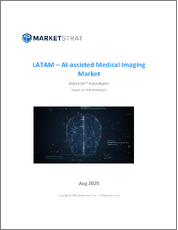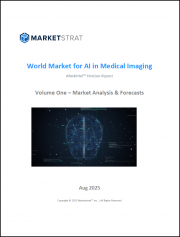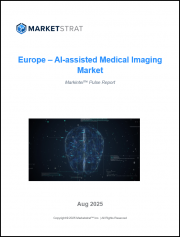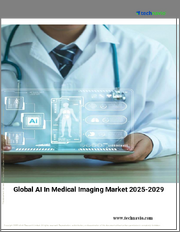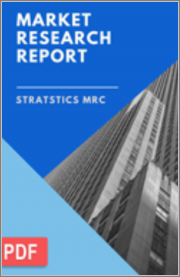
|
시장보고서
상품코드
1358975
세계의 의료 진단용 인공지능(AI) 시장 예측(-2030년) : 구성요소별, 전문 분야별, 모달리티별, AI 기술별, 용도별, 최종사용자별, 지역별 분석Artificial Intelligence in Medical Diagnostics Market Forecasts to 2030 - Global Analysis By Component, Specialty, Modality, AI Technology, Application, End User and By Geography |
||||||
Stratistics MRC에 따르면, 의료 진단용 인공지능(AI) 세계 시장은 2023년 13억 달러로 예측 기간 동안 34.2%의 CAGR로 성장해 2030년 105억 달러에 달할 것으로 예상됩니다.
의료 진단에 있어 인공지능(AI)은 의료진이 환자에게 정확하고 시기적절한 치료 방침을 결정할 수 있도록 지원함으로써 의료 접근성과 의료비용을 개선할 수 있는 잠재력을 가지고 있습니다. 병을 정확하게 진단하기 위해서는 수년간의 의학 교육과 많은 시간이 필요합니다. 의료 진단에 AI를 적용하면 정확한 진단을 제공하고, 임상 판단을 지원하며, 의료 전문가의 판단을 개선할 수 있는 능력을 입증했습니다.
헬스케어 데이터 활용성 확대
전자건강기록(EHR), 의료영상 데이터, 유전체 데이터 등 방대한 양의 데이터를 쉽게 얻을 수 있게 되면서 AI 모델 개발 및 검증이 가능해졌습니다. 또한, 헬스케어 데이터의 디지털화와 상호 운용 가능한 시스템의 도입으로 이러한 데이터의 수집과 활용이 용이해지면서 AI 알고리즘이 다양한 환자군을 대상으로 학습하고 진단의 정확도를 높일 수 있게 되었습니다.
예산 제약
헬스케어 기업이 직면한 주요 장애물은 자금 조달이며, 특히 개발도상국에서는 의료기기보다 IT 자금을 우선순위에 두는 것이 어렵습니다. 특히 의료보험이 잘 되어 있지 않은 국가에서는 영상진단 장비의 높은 비용과 AI 소프트웨어의 도입 및 라이선스 비용이 시장 성장을 제한하는 주요 문제입니다. 예를 들어, 높은 설치 및 유지보수 비용으로 인해 대부분의 개발도상국 의료시설은 AI 솔루션을 도입할 여력이 없습니다. 이러한 요인으로 인해 혁신적인 시스템이나 최첨단 시스템의 도입이 저해되고 있습니다.
빅데이터의 활용 가능성
빅데이터(거대하고 복잡한 데이터)는 산업계의 디지털화와 정보 시스템 도입으로 인해 의료 서비스 제공 과정의 여러 단계에서 생성되고 있습니다. 의료 진단 분야의 빅데이터에는 특히 클릭 스트림, 웹 및 소셜 미디어에서 생성되는 정보, 센서와 같은 의료기기 판독값, 심전도, 엑스레이 및 기타 청구 기록, 생체 데이터 등이 포함됩니다. 또한, 최근 몇 년 동안 EHR, 디지털화된 검사 슬라이드, 고해상도 방사선 영상이 의료진에게 수용되면서 빅데이터 및 분석 솔루션은 비약적으로 발전하고 널리 활용되고 있습니다.
해석 가능성과 투명성의 부족
특히 AI 알고리즘에 사용되는 딥러닝 모델은 복잡하고 이해하기 어려울 수 있습니다. 의료진은 AI가 어떻게 결론을 내리는지 모호하기 때문에 AI가 생성한 진단의 논리를 신뢰하고 이해하기 어려울 수 있습니다. 그러나 AI 모델이 의료 전문가들에게 수용되고 인정받기 위해서는 접근 가능하고 측정 가능해야 합니다.
COVID-19의 영향:
COVID-19의 유행은 전 세계 의료 산업에 부정적인 영향을 미쳤고, COVID-19의 감염률이 급격히 증가하여 전 세계 의료 시스템에 큰 부담을 주었으며, COVID-19 환자는 일반적으로 폐에 문제가 발생합니다. 따라서 심흉부 영상진단은 COVID-19 환자의 중증도를 판단하는 표준 진단 절차로, 2020년에는 COVID-19 진단에 AI를 활용하는 연구가 급속히 증가하였습니다.
예측 기간 동안 소프트웨어 부문이 가장 큰 비중을 차지할 것으로 예상
정확한 진단을 적시에 제공하기 위해 진단 분야에서 AI 기반 소프트웨어에 대한 수요 증가, 새로운 AI 알고리즘의 급속한 개발 및 새로운 소프트웨어의 승인, 방사선과, 순환기과, 신경과, 부인과, 안과 등 다양한 분야에서 AI 기반 소프트웨어의 적용이 증가함에 따라, 소프트웨어 부문이 예측 기간 동안 가장 큰 점유율을 차지했습니다. 또한, 직원 부족과 이미지 스캔의 증가에 대응해야 하는 과제에도 불구하고, 소프트웨어 솔루션은 의료 서비스 제공업체에게 경쟁업체에 대한 경쟁력을 제공하고 있습니다.
예측기간 동안 가장 높은 CAGR을 기록할 것으로 예상되는 분야는 병원 분야
병원에서 진단 자동화 및 업무량 감소를 위한 AI 기반 솔루션 도입의 이점, 진단 절차를 받는 환자 수 증가, 질병 조기 발견에 대한 수요 증가, 전문의 부족 등의 요인으로 인해 병원 부문은 예측 기간 동안 수익성 있는 성장을 이룰 것으로 예상됩니다. 또한, 복잡성과 오류를 줄이고 비용과 시간을 절약하며 전문가와 숙련공이 빠르고 쉽게 수행할 수 있도록 진단에 사용되는 AI 기반 의료 기술에 대한 병원의 요구가 증가하고 있습니다. 많은 병원들이 디지털 기업들과 협력하여 환자에게 클라우드 기반 AI 서비스 및 솔루션을 제공하고 있습니다. 이러한 솔루션을 일상 업무에 활용함으로써 병원은 생산성과 효율성을 높일 수 있습니다.
가장 큰 점유율을 차지하는 지역:
다양한 만성 질환 및 감염성 질환의 발병률 증가, 중국과 인도를 중심으로 한 AI 기반 스타트업의 증가, 지역 의료 인프라의 격차를 해소할 수 있는 AI의 엄청난 잠재력으로 인해 아시아태평양이 예측 기간 동안 가장 큰 점유율을 차지할 것으로 예상됩니다. 또한, 주식 투자 및 스타트업 인큐베이팅의 가능성은 이 지역 시장 발전에 영향을 미치고 있습니다. 이 지역의 고령화율 증가와 급성 및 만성 질환의 유병률 증가는 모두 이 지역의 시장 확대를 촉진할 것으로 예상됩니다.
CAGR이 가장 높은 지역:
아시아태평양은 정확하고 빠른 진단에 대한 수요 증가와 전 세계 고령화로 인한 만성 질환의 빈도 증가 등의 요인으로 인해 수익성 높은 성장이 예상됩니다. 이 밖에도 방사선과 의사가 의료 영상을 해석하고 신속하고 정확한 진단을 내릴 수 있도록 돕고, 의료 영상의 노이즈를 줄이며, 저선량 방사선으로 고품질 영상을 생성하는 등 다양한 이점이 있습니다.
무료 맞춤형 서비스:
이 보고서를 구독하는 고객은 다음과 같은 무료 맞춤형 옵션 중 하나를 사용할 수 있습니다:
- 회사 프로필
- 추가 시장 기업의 종합적인 프로파일링(최대 3개사까지)
- 주요 기업 SWOT 분석(3개사까지)
- 지역 세분화
- 고객의 관심에 따른 주요 국가별 시장 추정 및 예측, CAGR(참고: 타당성 검토에 따른)
- 경쟁사 벤치마킹
- 제품 포트폴리오, 지리적 입지, 전략적 제휴를 기반으로 한 주요 기업 벤치마킹
목차
제1장 주요 요약
제2장 서문
- 개요
- 이해관계자
- 조사 범위
- 조사 방법
- 데이터 마이닝
- 데이터 분석
- 데이터 검증
- 조사 접근법
- 조사 소스
- 1차 조사 소스
- 2차 조사 소스
- 가정
제3장 시장 동향 분석
- 성장 촉진요인
- 성장 억제요인
- 기회
- 위협
- 용도 분석
- 최종사용자 분석
- 신흥 시장
- 신종 코로나바이러스 감염증(COVID-19)의 영향
제4장 Porter's Five Forces 분석
- 공급 기업의 교섭력
- 구매자의 교섭력
- 대체품의 위협
- 신규 참여업체의 위협
- 경쟁 기업 간의 경쟁 관계
제5장 세계의 의료 진단용 인공지능(AI) 시장 : 컴포넌트별
- 서비스
- 소프트웨어
- 기타 컴포넌트
제6장 세계의 의료 진단용 인공지능(AI) 시장 : 전문 분야별
- 산부인과(OB-GYN)
- 흉부와 폐
- 종양학
- 뇌와 신경
- 방사선과
- 기타 전문 분야
제7장 세계의 의료 진단용 인공지능(AI) 시장 : 모달리티별
- 초음파
- CT 스캔
- X선
- 기타 모달리티
제8장 세계의 의료 진단용 인공지능(AI) 시장 : AI 기술별
- 상황인식 컴퓨팅
- 머신러닝
- 컴퓨터 비전
- 기타 AI 기술
제9장 세계의 의료 진단용 인공지능(AI) 시장 : 용도별
- 체외 진단
- 생체 내 진단
- 임상 의사 결정 지원
- 컴퓨터 지원 진단
- 기타 용도
제10장 세계의 의료 진단용 인공지능(AI) 시장 : 최종사용자별
- 영상 진단 센터
- 병원
- 진단 연구소
- 기타 최종사용자
제11장 세계의 의료 진단용 인공지능(AI) 시장 : 지역별
- 북미
- 미국
- 캐나다
- 멕시코
- 유럽
- 독일
- 영국
- 이탈리아
- 프랑스
- 스페인
- 기타 유럽
- 아시아태평양
- 일본
- 중국
- 인도
- 호주
- 뉴질랜드
- 한국
- 기타 아시아태평양
- 남미
- 아르헨티나
- 브라질
- 칠레
- 기타 남미
- 중동 및 아프리카
- 사우디아라비아
- 아랍에미리트
- 카타르
- 남아프리카공화국
- 기타 중동 및 아프리카
제12장 주요 발전
- 계약, 파트너십, 협업, 합작투자
- 인수와 합병
- 신제품 발매
- 사업 확대
- 기타 주요 전략
제13장 기업 개요
- Agfa Healthcare
- Digital Diagnostics Inc.
- GE Healthcare
- Google Inc
- HeartFlow, Inc.
- IBM Corporation
- Imagen Technologies
- Intel Corporation
- International Business Machines Corporation
- Koninklijke Philips N.V
- Microsoft Corporation
- NovaSignal Corporation
- Riverain Technologies
- Siemens Healthineers AG
- Zebra Medical Vision Inc
According to Stratistics MRC, the Global Artificial Intelligence (AI) in Medical Diagnostics Market is accounted for $1.3 billion in 2023 and is expected to reach $10.5 billion by 2030 growing at a CAGR of 34.2% during the forecast period. By supporting healthcare professionals in making accurate and timely treatment decisions for their patients, artificial intelligence (AI) in medical diagnostics has the potential to improve access to and the cost of healthcare. It takes years of medical education and a lot of time to diagnose a condition accurately. The application of AI to medical diagnosis has demonstrated its ability to provide precise diagnoses, support clinical decisions, and improve healthcare professionals judgment.
According to the data by the World Bank, USD 1,111.082 was spent per capita on healthcare in 2018.
Market Dynamics:
Driver:
Expansion of healthcare data availability
Electronic health records (EHRs), medical imaging data, and genomic data, which have become readily available in huge amounts, have made it possible to develop and validate AI models. Moreover, the collection and use of these data have been made easier by the digitization of healthcare data and the deployment of interoperable systems, enabling AI algorithms to learn from a variety of patient groups and increase diagnostic precision.
Restraint:
Budgetary limitations
The main obstacle facing healthcare companies is funding, particularly in developing nations where it is difficult to prioritize IT funds over medical equipment. Particularly in nations where the reimbursement situation is unfavorable, the high cost of imaging equipment and the implementation and licensing expenses of AI software are the main issues limiting market growth. However, due to high installation and maintenance costs, for instance, the majority of healthcare facilities in developing nations cannot afford AI solutions. The adoption of innovative or cutting-edge systems is being hampered by this factor.
Opportunity:
Availability of big data
Big data (huge and complex data) is produced at various phases of the care delivery process as a result of the industry's growing digitization and adoption of information systems. Big data in the field of medical diagnostics includes, among other things, information generated from clickstream and web and social media interactions, readings from medical devices like sensors, ECGs, X-rays, and other billing records, as well as biometric data. Additionally, with the increasing acceptance of EHRs, digitized laboratory slides, and high-resolution radiological images among medical professionals over the past few years, big data and analytical solutions have become exponentially more advanced and widely used.
Threat:
Lack of interpretability and transparency
Deep learning models in particular, which are used in AI algorithms, can be complex and challenging to understand. Healthcare practitioners might discover it difficult to trust and comprehend the logic behind AI-generated diagnoses due to the ambiguity of how AI comes to its conclusions. However, AI models must be accessible and measurable in order to be accepted and recognized by healthcare professionals.
COVID-19 Impact:
The COVID-19 pandemic epidemic had a negative impact on the worldwide healthcare industry. The COVID-19 infection rate increased dramatically, placing an enormous burden on the global health system. Patients with COVID-19 typically experience lung problems. Therefore, to determine the severity of the disease in COVID-19 instances, cardiothoracic imaging is a standard diagnostic procedure. In 2020, the number of studies utilizing AI to diagnose COVID-19 rapidly increased.
The software segment is expected to be the largest during the forecast period
Due to the rising demand for AI-based software in diagnostics to provide an accurate diagnosis in a timely manner, the rapid development of new AI algorithms and new software approvals, and the applications of AI-based software in a variety of fields, including radiology, cardiology, neurology, gynecology, and ophthalmology, among others, the software segment held the largest share over the projection period. Additionally, despite the challenges of having a shortage of employees and the need to deal with rising imaging scan volumes, software solutions give healthcare providers a competitive edge over their rivals.
The hospitals segment is expected to have the highest CAGR during the forecast period
Due to factors like the benefits of implementing AI-based solutions to automate diagnosis and reduce workload in hospitals, the rise in the number of patients undergoing diagnostic procedures, the expanding demand for early disease detection, and the shortage of medical specialists, the hospital segment is predicted to experience profitable growth throughout the forecast period. Furthermore, there is a growing need for AI-based medical technologies in hospitals that are used for diagnosis in order to reduce complexity and errors, save money and time, and be performed quickly and easily by professionals and skilled workers. Many hospitals have partnerships with digital firms to offer cloud-based AI services and solutions to their patients. By using these solutions in their daily operations, the hospitals will increase their productivity and efficiency.
Region with largest share:
Owing to the rising incidence of various chronic and infectious diseases, the rising number of AI-based startups, particularly in China and India, and the enormous potential of AI in filling the gap in the region's healthcare infrastructure, Asia Pacific is predicted to hold the largest share over the extrapolated period. Moreover, the availability of equity investments and start-up incubation has an impact on the development of regional markets. The region's rising aging population and higher prevalence of acute and chronic illnesses are both expected to boost market expansion in the region.
Region with highest CAGR:
Due to factors including the increasing demand for accurate and prompt diagnosis and the rising frequency of chronic diseases owing to the aging population worldwide, Asia-Pacific is expected to have profitable growth. Additionally, the benefits offered by AI-based solutions in the diagnosis of different neurological diseases, such as helping radiologists interpret medical images to make a rapid and precise diagnosis, reducing noise in medical images, and producing high-quality images from lower doses of radiation, are enhancing regional growth.
Key players in the market:
Some of the key players in Artificial Intelligence (AI) in Medical Diagnostics market include: Orthofix Medical Inc., NuVasive, Inc., Baxter International Inc, OrthoPediatrics Corp., Arthrex, Inc, AlloSource, Wright Medical Group N.V., Stryker Corporation, GreenBone Ortho, Zimmer Biomet Holdings, Inc, Smith & Nephew Plc, GRAFTYS, Medtronic Plc, Bioventus Inc, Musculoskeletal Transplant Foundation, SeaSpine, GreenBone Ortho.
Key Developments:
In September 2023, IBM commits to train 2 million in artificial intelligence in three years, with a Focus on Underrepresented Communities. To achieve this goal at a global scale, IBM is expanding AI education collaborations with universities globally, collaborating with partners to deliver AI training to adult learners, and launching new generative AI coursework through IBM SkillsBuild. This will expand upon IBM's existing programs and career-building platforms to offer enhanced access to AI education and in-demand technical roles.
In September 2023, IBM is offering a robust FSMA 204 traceability and compliance management solution capable of supporting the needs of the industry's largest enterprises and suppliers of all sizes. The solution combines the scalability and interoperability of the IBM Sterling Supply Chain Intelligence Suite and the IBM Food Trust Network with iFoodDS' traceability applications and innovative food industry, regulatory, and technical expertise.
Components Covered:
- Services
- Software
- Other Components
Specialties Covered:
- Obstetrics & Gynecology (OB-GYN)
- Chest & Lung
- Oncology
- Brain & Neurological
- Radiology
- Other Specialties
Modalities Covered:
- Ultrasound
- CT Scan
- X-ray
- Other Modalities
AI Technologies Covered:
- Context-Aware Computing
- Machine Learning
- Computer Vision
- Other AI Technologies
Applications Covered:
- In Vitro Diagnostics
- In Vivo Diagnostics
- Clinical Decision Support
- Computer-Aided Diagnosis
- Other Applications
End Users Covered:
- Diagnostic Imaging Centers
- Hospitals
- Diagnostic Laboratories
- Other End Users
Regions Covered:
- North America
- US
- Canada
- Mexico
- Europe
- Germany
- UK
- Italy
- France
- Spain
- Rest of Europe
- Asia Pacific
- Japan
- China
- India
- Australia
- New Zealand
- South Korea
- Rest of Asia Pacific
- South America
- Argentina
- Brazil
- Chile
- Rest of South America
- Middle East & Africa
- Saudi Arabia
- UAE
- Qatar
- South Africa
- Rest of Middle East & Africa
What our report offers:
- Market share assessments for the regional and country-level segments
- Strategic recommendations for the new entrants
- Covers Market data for the years 2021, 2022, 2023, 2026, and 2030
- Market Trends (Drivers, Constraints, Opportunities, Threats, Challenges, Investment Opportunities, and recommendations)
- Strategic recommendations in key business segments based on the market estimations
- Competitive landscaping mapping the key common trends
- Company profiling with detailed strategies, financials, and recent developments
- Supply chain trends mapping the latest technological advancements
Free Customization Offerings:
All the customers of this report will be entitled to receive one of the following free customization options:
- Company Profiling
- Comprehensive profiling of additional market players (up to 3)
- SWOT Analysis of key players (up to 3)
- Regional Segmentation
- Market estimations, Forecasts and CAGR of any prominent country as per the client's interest (Note: Depends on feasibility check)
- Competitive Benchmarking
- Benchmarking of key players based on product portfolio, geographical presence, and strategic alliances
Table of Contents
1 Executive Summary
2 Preface
- 2.1 Abstract
- 2.2 Stake Holders
- 2.3 Research Scope
- 2.4 Research Methodology
- 2.4.1 Data Mining
- 2.4.2 Data Analysis
- 2.4.3 Data Validation
- 2.4.4 Research Approach
- 2.5 Research Sources
- 2.5.1 Primary Research Sources
- 2.5.2 Secondary Research Sources
- 2.5.3 Assumptions
3 Market Trend Analysis
- 3.1 Introduction
- 3.2 Drivers
- 3.3 Restraints
- 3.4 Opportunities
- 3.5 Threats
- 3.6 Application Analysis
- 3.7 End User Analysis
- 3.8 Emerging Markets
- 3.9 Impact of Covid-19
4 Porters Five Force Analysis
- 4.1 Bargaining power of suppliers
- 4.2 Bargaining power of buyers
- 4.3 Threat of substitutes
- 4.4 Threat of new entrants
- 4.5 Competitive rivalry
5 Global Artificial Intelligence (AI) in Medical Diagnostics Market, By Component
- 5.1 Introduction
- 5.2 Services
- 5.3 Software
- 5.4 Other Components
6 Global Artificial Intelligence (AI) in Medical Diagnostics Market, By Specialty
- 6.1 Introduction
- 6.2 Obstetrics & Gynecology (OB-GYN)
- 6.3 Chest & Lung
- 6.4 Oncology
- 6.5 Brain & Neurological
- 6.6 Radiology
- 6.7 Other Specialties
7 Global Artificial Intelligence (AI) in Medical Diagnostics Market, By Modality
- 7.1 Introduction
- 7.2 Ultrasound
- 7.3 CT Scan
- 7.4 X-ray
- 7.5 Other Modalities
8 Global Artificial Intelligence (AI) in Medical Diagnostics Market, By AI Technology
- 8.1 Introduction
- 8.2 Context-Aware Computing
- 8.3 Machine Learning
- 8.4 Computer Vision
- 8.5 Other AI Technologies
9 Global Artificial Intelligence (AI) in Medical Diagnostics Market, By Application
- 9.1 Introduction
- 9.2 In Vitro Diagnostics
- 9.3 In Vivo Diagnostics
- 9.4 Clinical Decision Support
- 9.5 Computer-Aided Diagnosis
- 9.6 Other Applications
10 Global Artificial Intelligence (AI) in Medical Diagnostics Market, By End User
- 10.1 Introduction
- 10.2 Diagnostic Imaging Centers
- 10.3 Hospitals
- 10.4 Diagnostic Laboratories
- 10.5 Other End Users
11 Global Artificial Intelligence (AI) in Medical Diagnostics Market, By Geography
- 11.1 Introduction
- 11.2 North America
- 11.2.1 US
- 11.2.2 Canada
- 11.2.3 Mexico
- 11.3 Europe
- 11.3.1 Germany
- 11.3.2 UK
- 11.3.3 Italy
- 11.3.4 France
- 11.3.5 Spain
- 11.3.6 Rest of Europe
- 11.4 Asia Pacific
- 11.4.1 Japan
- 11.4.2 China
- 11.4.3 India
- 11.4.4 Australia
- 11.4.5 New Zealand
- 11.4.6 South Korea
- 11.4.7 Rest of Asia Pacific
- 11.5 South America
- 11.5.1 Argentina
- 11.5.2 Brazil
- 11.5.3 Chile
- 11.5.4 Rest of South America
- 11.6 Middle East & Africa
- 11.6.1 Saudi Arabia
- 11.6.2 UAE
- 11.6.3 Qatar
- 11.6.4 South Africa
- 11.6.5 Rest of Middle East & Africa
12 Key Developments
- 12.1 Agreements, Partnerships, Collaborations and Joint Ventures
- 12.2 Acquisitions & Mergers
- 12.3 New Product Launch
- 12.4 Expansions
- 12.5 Other Key Strategies
13 Company Profiling
- 13.1 Agfa Healthcare
- 13.2 Digital Diagnostics Inc.
- 13.3 GE Healthcare
- 13.4 Google Inc
- 13.5 HeartFlow, Inc.
- 13.6 IBM Corporation
- 13.7 Imagen Technologies
- 13.8 Intel Corporation
- 13.9 International Business Machines Corporation
- 13.10 Koninklijke Philips N.V
- 13.11 Microsoft Corporation
- 13.12 NovaSignal Corporation
- 13.13 Riverain Technologies
- 13.14 Siemens Healthineers AG
- 13.15 Zebra Medical Vision Inc






